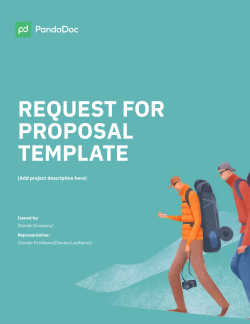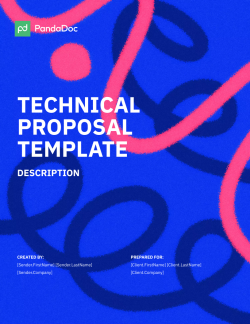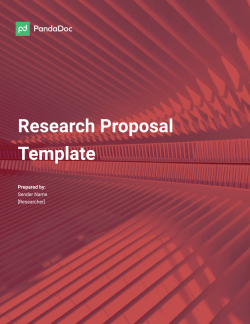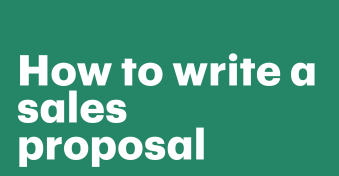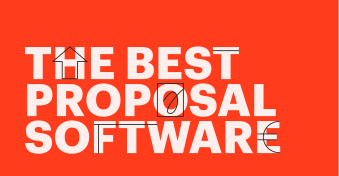Writing a technical proposal entails an in-depth understanding of the proposed solution, the main pain points, and, ultimately, your audience.
In technical writing, writing the content of a proposal can be overwhelming and time-consuming, even more so if you don’t have a technical background.
However, a successful proposal can result in a new project and/or client when done well.
Now, in 2023, more and more marketers are turning to automatization for help to streamline these technical processes.
Whether in construction, education, healthcare, software, technology, or manufacturing, there is an appropriate automated option that can help achieve the best results.
This article aims to help you better understand (and write) technical proposals.
We’ll cover the process step by step and show you how to master your next technical proposal.
→DOWNLOAD NOW: FREE TECHNICAL PROPOSAL TEMPLATE
What is a technical proposal?
A technical proposal is a type of document that outlines the precise details of a proposed product or service.
This document may contain any of the following:
- Technical requirements
- Design considerations
- Functional specifications
- Bills of materials
- Overall cost estimation
Technical proposals are often tailored for specific projects and must be comprehensive in order to be successful.
In addition to outlining the core elements of the project, a technical proposal should also include supporting evidence such as data from research studies or reports from industry experts.
By leveraging data and professional experience in a precise way, a technical proposal introduces products and initiatives while also explaining how they address the recipient’s problem and the company’s execution plan.
While this type of proposal is often brief, it can quickly become very complex.
While writing, remember that the proposal needs to explain a complex product in relatively simple terms.
What is technical proposal writing?
Technical proposal writing is translating technical requirements into a customer-facing proposal used to pitch your solution or offerings.
Considering the situation in which your proposal occurred and depending on its nature, technical proposal writing might encompass only a small section of the proposal — particularly regarding project execution, the intended scope of work, and the equipment or materials involved.
However, that isn’t always the case.
Some business sectors and proposals are technical by nature from start to finish, and this becomes more common as the cost of a project increases.
As you might expect, multimillion-dollar projects will be reviewed with far greater scrutiny than small sales projects costing a few hundred dollars.
Keep in mind that different proposals require different methodologies and concepts, depending on the nature of the project and its requirements.
Often, technical proposals will be guided by a request for proposal (RFP) from the potential client or stakeholder.
The proposal writer will use the guidelines in the RFP to construct a technical proposal that meets specific project requirements and explains how your organization can meet those needs.
Technical proposal formatting: How to format a technical proposal?
Quick tip before you start: If you don’t want to spend your time writing technical proposals from scratch each time a project comes your way, you can always turn to the technical proposal template in the PandaDoc library.
It’s a great starting point, being both beautifully designed and arranged with a framework that you expand into your own unique template.
Our technical proposal template covers many technical proposal sections you need in a successful document of this type; in addition, we give you useful information on how to fill it out effectively.
As you read through the rest of the article, bear in mind that the majority of companies working up proposals do so using templates and similar fast formatting tools.
To stay competitive, be prepared to write content for your technical proposal that can be quickly copied and personalized to fit a new client.
With those essentials out of the way, here are essential elements of technical proposal formatting.
1. Prepare your proposal introduction
Ensure that your introduction does all of the following (not necessarily in this order):
- State that the memo contains a proposal for a specific project. (Quote an RFP number or a project number if you have one.)
- Address the needs of the project, the company, and the stakeholders directly and position the proposal content as a solution that meets the requested criteria.
- Give an overview of the proposal’s content, what readers should expect, and why you feel that your proposed solution is the best way forward.
- If your proposal is unsolicited, the introduction needs to convince the reader that your proposal is an opportunity that should be explored.
2. Background information on the issue
A summary background often follows the introduction and outlines the necessity for the project.
This section typically defines the problem, the opportunity for improvement, and the scenario.
While the specified audience of the proposal may be familiar with the issue, writing the background section helps demonstrate your unique perspective.
3. Project benefits and feasibility
Most proposals briefly explain the project’s benefits and its success rate in the form of a pro-project argument.
In an unsolicited proposal, this section is critical to “sell” the project to the audience.
4. Proposed task description (results of the project)
Most proposals must describe the final product.
Proper technical proposal formatting entails identifying the document’s audience and purpose, providing an overview, and considering length, graphics, binding, etc.
Most proposals also explain how you will complete the work.
This adds to your persuasiveness and demonstrates you have done your homework. It also shows that you know the field well enough to finish the project.
5. Schedule
Most proposals include a section detailing the project’s completion date, as well as significant milestones.
If you’re working on a long-term project, the timeline will include due dates for progress reports. If you can’t give dates, give time frames for each phase of the project.
6. Resources and costs
Most proposals include a section on project costs and require you to include your hourly rates, expected hours, equipment and supply prices, and so on before calculating the final project cost.
If you need to run any Internal projects in order to fulfill your proposal, keep in mind that those resources aren’t free.
You should still disclose the project costs: time spent on the project, equipment and supplies used, and factor that in as an operating expense.
5. Conclusions
The closing paragraph or portion of the proposal should remind readers of the project benefits.
Your last section should entice them to contact you to discuss the project in detail and perhaps make one last case for why you or your firm is the best candidate for the job.
Always consider what more your audience would need to comprehend the project, its necessity, its benefits, your position in it, and your qualifications.
Always ask yourself: What else does a potential client need to know in order to approve the project, and what do you need in order to complete the work?
How long should a technical proposal be?
Creating a great proposal is always a classic Goldilocks problem.
It can’t be too long or too short. It needs to be precisely the correct length.
Your pitch should be brief, but not so short that it omits important information.
It should not be excessively long, either, as this may cause your client to skim or skip sections.
Proposals of 10 to 20 pages are typical, but some clients prefer short concept notes, while others rather go for extensive proposals of 50 pages or more.
This is, however, merely a framework metric.
Often, you can get a good idea of the desired length based on the information than an RFP is asking for.
If you don’t have an RFP to use as a guideline, any information you can gather from the client about their needs will give you a better understanding of the space you need to address the problem.
Types of technical proposals
There are four main types of proposals.
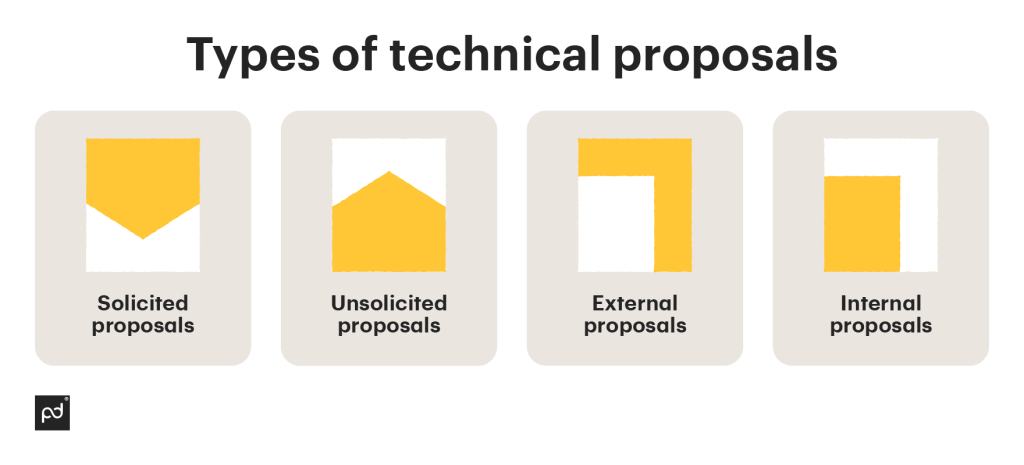
When writing a technical proposal, the type of proposal you intend to write will have a major impact on the technicalities you should provide and the language you need to use in order to win the contract.
1. Solicited proposals
Solicited proposals are proposals that have been requested from another party.
A potential client or project stakeholder has reached out to your team or business and requested information on how you might solve a problem.
2. Unsolicited proposals
Unsolicited proposals are proposals that you have arranged and sent based on a need or opportunity that you have discovered.
Rather than being ask, your business has approached an organization with the intent to provide a product or a service.
3. External proposals
External proposals are sent to an individual or company external to your own organization.
These proposals will rely on details, information, and project specifications from the external party and are usually done for profit.
4. Internal proposals
Internal proposals are used to pitch projects, ideas, and initiatives to stakeholders within your own organization.
These initiatives could include changes in policy, new modes of business operation, or ventures into a new sector of business.
They are not usually done for profit, aside from budget allocations and financial approvals within the company.
Each of these proposals can be technical in nature, depending on the type of business and the work that needs to be done.
Often, technical proposals are created in response to a request for proposal (RFP) document, which outlines the need of the organization and the requirements or specifications that any solution must entail.
Internal requests don’t often contain formal RFP documents, but proposals may be created in response to a summary list of needs (sometimes sent via email or discovered through meetings and internal conversations).
In some sense, any kind of proposal you write has the potential to be a technical proposal. However, some proposals will be more technical than others.
Here’s a closer look at several common proposal types and how they may be written in a technical way.
5. Business proposal or sales proposal
Sales proposals and business proposals are external documents delivered to buyers or consumers outside of the company.
They vary greatly in style and form, ranging from short, one-page proposals to full-length, detailed documents that offer much greater specificity.
At the short end, these types of proposals can be very simple.
However, when the external organization requires very specific solutions or the project is very competitive, a greater level of technical expertise may be required to explain why your organization should win the contract.
The RFP for a project may also require technical documentation that demonstrates how a solution will work, including details surrounding past successes, expected results, and statements of work detailing what must be done.
The stakeholder may need to know about key personnel involved, the equipment or facilities you intend to you to complete the project, and much more.
As the requirements begin to accumulate, you may find yourself supplying highly technical documentation in the middle of your sales or business proposal!
However, though the documentation may be complex, it is often repeatable.
In fact, most organizations that rely on RFPs as a means of profit use proposal template software tools like the PandaDoc content library and document builder to accelerate the speed at which proposals can be compiled and sent.
6. Research proposals
A research proposal is a document outlining the scope of a project, including the research questions or hypotheses to be answered, the methodology, and any potential outcomes.
It may also include a budget estimate for conducting the research work and an indication of how much time it will take to complete.
These proposals are most common in academia and in the non-profit sector, where funding may come from external sources like foundational or government grants.
In this case, the grant-providing organization will typically post a call for project submissions based on a theme or initiative, then fund projects that further their organizational directives.
Because of the competition surrounding these projects and the specific nature of the research, these proposals can become very technical in very short order.
(Check out our research proposal template for a comprehensive proposal layout that you can use for your next research project.)
Winning research proposals need to explain, often in a technical manner, why a project is important, how it aligns with organizational goals, the nature of the work involved, and how that work will be performed.
It must be carefully planned out and written with precision so that all stakeholders can understand its purpose and assess whether or not it should receive their support.
7. Real estate development
Designing even a single building can quickly become a multimillion dollar project, so you won’t have to go very far in this field to begin feeling the pressure for technical details.
Real estate development proposals (template here) need to cover aspects of construction, suppliers, government regulations, and more.
It needs to have solid construction timelines, specify what materials will be used, where those materials will be sourced, how projects will be financed, and more.
All aspects of a project like this require a measure of technical expertise.
Because these projects are typically financed by a bank or similar third-party backer, major development projects will be heavily scrutinized for flaws and cost-saving opportunities.
How to write a technical proposal
In this section, we’ll walk you through the process of preparing a technical proposal one step at a time. We’ll cover every major section of your proposal, what it should include, and how you should approach it.
Keep in mind that proposal formats may vary — both in RFP specifications and due to the nature of your business — so use these steps as guidelines and tailor your final proposal to the needs of your business.
Note: This section is focused primarily on external proposals. Internal proposals, even when technical, are often more informal and may follow relaxed guidelines.
For the format in this section, our team relied on a great proposal guideline from the John and Marcia Price College of Engineering.
Your format may vary, but this is a great starting point.
→DOWNLOAD NOW: FREE TECHNICAL PROPOSAL TEMPLATE
1. Prepare an executive summary, abstract, or cover letter
Provide a summary of your proposal in one page or less, presenting an overview of the proposed work.
Make sure your proposal writing is carefully put together and covers all elements and deliverables you plan to tackle:
- Indicate that your memo content revolves around a proposal for a specific project.
- Develop at least one direct, to-the-point, motivating statement that will compel the recipient to read on and consider supporting or approving the project.
- Provide a brief overview of the contents of the proposal.
It is not necessary you lay things out in this order, but be sure to include each element in your summary.
If you are writing a proposal on your own, you can expedite this process by using a proposal template.
Follow the outlined workflow and formatting, and stay on point.
Make modifications where necessary to fit the needs of your business or project.
Here’s a good example of how you can put together an executive summary for a website development proposal.
2. Put together a table of contents
A table of contents (TOC) shows readers what topics the technical proposal covers, how the document is arranged, and where they can find specific sections and subsections.
A well-organized table of contents provides an at-a-glance way of finding information in the proposal. In that sense, it is crucial you apply proper formatting in your TOC design structure.
Keep in mind that stakeholders may not read your proposal from cover to cover.
They are likely to skip and skim sections and to consider the document in an asymmetrical manner, with more time spent on solutions, costs, and other key factors.
When preparing your document, consider the following:
1. Levels of headings
If your proposed project is longer, consider including more than the top two levels of headings.
Your header structure will dramatically impact the look and feel of your TOC and can keep it from becoming unwieldy or overwhelming.
2. Indentation, spacing, and capitalization
Make sure all levels of headings and page numbers are aligned with one other.
For capitalization, ensure that you follow the same heading structure on a per-level basis.
If your H1 headings are fully capitalized, be sure that all headings designated as H1 follow this format.
The same is true for other header styles.
3. Vertical spacing
For increased readability of your entire proposal, format the first-level sections so they have extra space above and below.
Work to keep the formatting and styling consistent throughout your document, and use the automatically generated TOC to get a clear overview of your document.
3. Technical background, opportunity, or situation
Provide background that identifies the problem; discuss what has inspired the need for the project, and provide motivation explaining why such a task would be essential or beneficial.
Reflect on the present opportunity to improve things in your proposed project while explaining the basic situation.
If you have an RFP, use the information provided by the RFP document to build this section.
Speak directly to the needs indicated by the client documentation and use those problems to explain the benefit of your solution.
While most of the proposal’s named audience may already be familiar with this very well, writing the background section is valuable as it demonstrates your particular view of the situation.
If this is an unsolicited proposal, a background section is a must.
You will have to convince the audience that this is the right time for your proposal assignment (as the opportunity exists) and that it should be addressed.
3.1 Justification, benefits, and feasibility of the proposed work
How you approach the justification for the work will vary based on the nature of the proposal.
For proposals responding to an RFP, project stakeholders have already decided to undertake a project and won’t need an explanation of why the project is good or feasible for their business operations.
However, they will expect a justification for why your solution is the best option compared to your competitors.
Use results from past projects, technical data regarding your equipment, and similar information that makes your solution stand out.
If you are submitting an unsolicited proposal, take the extra time to discuss your justifications for the project, why the client should undertake such a venture, and what the likely outcomes will be.
Unsolicited proposals often hit a roadblock in this area because the company has not yet made the internal decision to spend money.
You may be selling to a company that lacks the budget or initiative to fund a project. It’s also possible that, even if you uncover a need, the organization may only hire through a competitive process.
This section is often the largest and tends to contain numerous subsections such as:
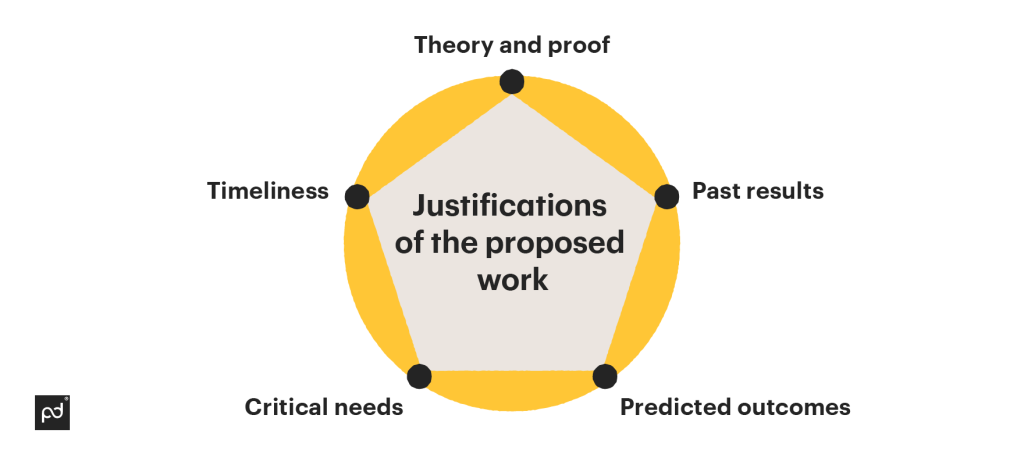
1. Theory and proof
This section may tackle your argument or reasoning regarding the benefits of your proposed work and provide data that supports your solution as the best option available to potential clients.
2. Past results
Often, this section is used to offer outcomes from past results (case studies, measurable improvements, etc.) from previous projects with similar needs.
3. Predicted outcomes
This category, often tailored to fit the needs of the business or speak to a specific set of problems, tries to give realistic expectations (and supporting data) that stakeholders can use to set expectations and gauge ROI.
4. Critical needs
Here, writers often highlight critical needs that should be addressed as part of the work.
This section may address the needs put forward in an RFP, but it can also cover the critical needs of the project or unforeseen needs that the client has overlooked.
5. Timeliness
This section aims to justify the project based on timeliness.
A common argument is that the industry is changing or evolving, and a specific solution is needed to ensure business longevity.
The “why now?” argument is answered here, and the concept of “future-proofing” is often a topic of discussion.
4. Technical approach, resources, and costs required
Most proposals contain a section resembling a progress report detailing the approach to the projects, resources, objectives, and costs required.
This may require a detailed list of costs of equipment and supplies, your hourly rates, projected hours, and so forth, and then calculate the total cost of the entire proposal.
Though often less formal, this approach may also be true for internal proposals, especially if you require a budget allocation or need to convince internal stakeholders to invest time and effort into a major initiative.
Internal projects are often misconstrued as “free” projects, but they incur costs in resource, labor, and opportunity.
Here is a part of the proposal that is typically included in this section:
4.1 Objectives
Pinpoint the specific things you plan to achieve with this project.
This section might exact changes you intend to make, equipment you intend to install, or processes and workflows that may need to be optimized, or work that you intend to perform.
If your goals are metric-based, such as lowering a specific metric or improving performance in a given area, this section should detail those targets and why they matter.
4.2 Statement of work
The statement of work (SOW) is a document that covers and defines all components of a project’s scope of work.
It is legally binding and notes the project’s activities, deliverables, and timeline.
It’s a very detailed work contract that establishes the framework for the project plan.
Keep in mind that a statement of work is almost a document unto itself. (You can find several examples in the PandaDoc template library or in the community library.)
The SOW is one of the first, and most important documents you’ll create before planning and executing a project. Writing one can be intimidating due to the quantity of detail required.
You can learn more about statements of work and how to write them over here.
4.3 Project tasks
Provide a detailed list of itemized tasks (Task 1, Task 2, etc., with sub-tasks (if any), numbered Task 1.1) that need to be performed for the objectives listed above to be met.
Each task and subtask should come with a brief description.
You can also include additional information about which tasks can be performed simultaneously and which tasks must be performed chronologically.
4.4 Project calendar/schedule
Especially important for long-form projects, a project calendar or schedule will provide timelines regarding overall project completion.
Often, the final dates are dictated by the RFP. Depending on their own deadlines and initiatives, the client may have some flexibility.
In some instances (particularly if the RFP is based around time-limited funds or resources), the proposed deadline may be inflexible.
Your schedule will need to align with those proposed deadlines.
4.5 Expected costs
Determine costs per each task and the overall project completion.
Include estimates for all labor involved as well as any supply and equipment costs.
Overages and deviations from the budget price aren’t necessarily a dealbreaker.
Stakeholders may not have properly estimated the work required to complete the project.
Keep in mind that if your estimates are higher and every other proposal comes in at a lower cost, you could still lose the project.
5. Personnel and equipment
This section defines the qualifications and expertise that your team brings to the project.
Particularly when stakeholders are reviewing similar projects, the experience and history of your organization and its people will play a major factor in the client’s assessment of risk.
Typically, this section is broken into two major parts:
1. Key personnel
This section includes the members of your team who would be assigned to the project, along with their relevant expertise in a given field, any qualifications they might have, and what they can offer.
You won’t need to list every single team member, but the individuals in charge of the project (or those with valuable expertise) should be included.
2. Equipment or facilities
In this section, you’ll want to include any specialized equipment or unique facilities that will help you meet the project requirements.
If you have unique tools or a specialized shop to manufacture and modify components, these factors can help to set you apart from competitors.
6. Anticipated benefits
Here, you’ll want to focus on the benefits that the client can expect from your work.
This could include improved safety, increased efficiency, long-term cost savings, and a positive environmental impact.
The purpose of this section is not only to further justify the time and expense of carrying out this project but also to confirm that your project is superior to similar solutions offered by competitors.
Take the time to write a concise list of benefits and advantages that demonstrate the value of your project.
In doing so, this section can do the following:
Set yourself apart from the competition
The most significant goal of a project proposal is to showcase the advantages of your company over competitors.
A project proposal helps you clearly articulate these benefits and impact the potential client’s decision if your organization offers cheaper costs, stronger processes, or better-projected outcomes.
Ensure that everyone is on the same page about the project
Project proposals ensure that both parties understand what the project includes by stating the project’s goal and scope.
This shared understanding improves communication in the future and builds trust between a client and a sponsor.
Establish trustworthiness
A well-written project proposal explains how the vendor plans to execute the project and meet the client’s expectations.
Project proposals may also identify potential dangers and provide ways to mitigate them.
This high degree of communication persuades potential clients to know what goes into a project and what it takes to complete it.
Draw attention to a problem
Project proposals can also be utilized to draw attention to a problem that a corporation was previously unaware of.
Your document could describe why a client’s problems are urgent and why they need to be resolved in the shortest time frame possible.
For example, a freelance writer writing a project proposal to build a blog could highlight how much traffic their website is losing since they don’t have one.
Propose a budget and a timetable for the project
Although a project proposal isn’t a legally binding contract, it establishes the budget and timeline for a project’s completion.
Vendors and stakeholders can use the document to reach a preliminary agreement on the resources and time required to complete a project.
Assist with project planning
The project proposal serves as an outline to assist you schedule resources and decide on a strategy to meet the project’s objectives once you’ve signed a contract with a client.
Developing project proposals is an unavoidable part of any project manager’s job, but it doesn’t have to be tough or time-consuming.
You can make that procedure a lot easier if you look for it. Yes, you’ve guessed it – templates!
The project proposal template does more than just provide you with some ready-to-use language.
PandaDoc is laying out some benefits of using a project proposal template:
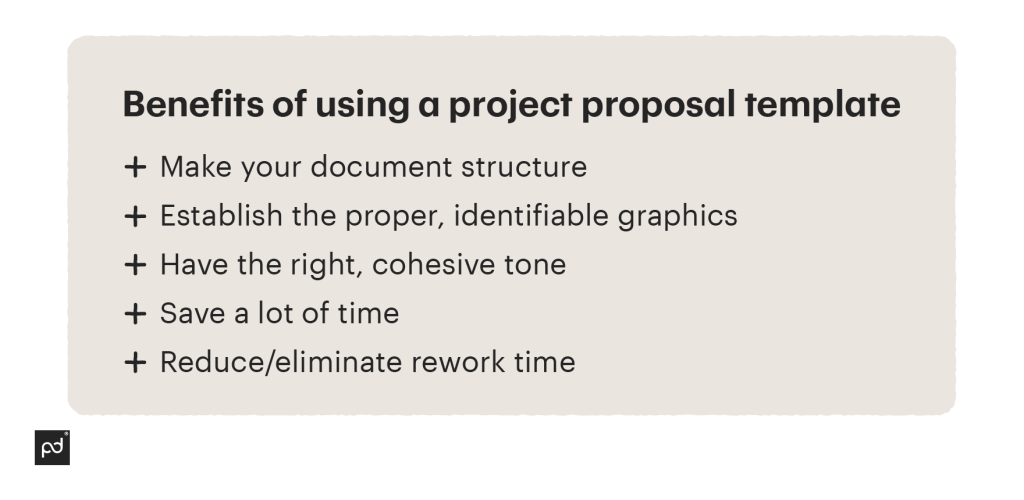
It also helps you:
- Make your document structure obvious so that the prospect can easily explore your grasp of the client’s problem, your proposal, approach, skills, schedule, and additional activities.
- Establish the proper, identifiable graphics that would prompt your prospect to engage you for the next project, too.
- Have the right, cohesive tone that makes it easy for the prospect to see you are already involved with them and are ready to solve their problem.
- Save a lot of time so you may concentrate on more important things.
- Reduce/eliminate rework time because you’ve already got a ready-to-use template on standby.
7. Conclusion
The conclusion of a technical proposal is the final paragraph or section of the proposal and is designed to bring readers back to the central idea of the proposal.
This final section should, once again, list all positive aspects of the project.
If you want to end your proposal on a solid note, urge the reader to contact you to work out project details further, remind them of this project’s benefits, and maybe remind them why you (and your team) are the right person to lead this project.
8. References and sources
References section lists resources cited in the body text and diverts readers to those sources should they need additional reading or checking of facts.
This tends to be more useful if you aren’t submitting electronic documents and can be used as a replacement for document footnotes.
However, if you can hyperlink stats, statistics, white papers, etc., this section may not be necessary.
Often, writers include documents and data here in the event that the proposal is printed and handled as a physical document.
9. Appendices
Nonessential but potentially helpful, an appendix contains supplementary material that provides a more comprehensive understanding of the research/topic at hand.
Appendices sections usually contain relational or technical information that is too complex or off-topic to be included in the body of the paper.
Often, this hyper-specific information may be more of interest to subject matter experts on the client side than project stakeholders who are more interested in a holistic view of your project or initiative.
Valuable tips and hacks for writing a successful technical proposal
Winning a project takes more than having a good idea. You need to have a captivating, persuasive approach that will convince a panel of reviewers your idea is worth considering and is likely to succeed.
With that in mind, here are eight extra tips for a winning technical proposal.
1. Write/present with your reviewers in mind
Make sure they understand your point. Use a clear and engaging writing style.
2. Address common questions clearly
Introduce them early in your proposal, especially if they were posed in the client RFP or reference documentation, and use them to connect with the reader.
3. Be sure of your relevance
Explain how your work, your history, and your experience impacts the bigger picture.
This will help to set your team apart from competitors offering similar solutions.
4. Refer to supporting research
Refer to supporting research relevant to your current idea.
This might include statistics, trends and patterns, or even case studies from past clients.
5. Address potential limitations
Address potential limitations and problems to show you understand the entire scope of the project.
Sometimes, this will lead to additional opportunities. It also serves to keep the client fully informed.
6. Have others review your proposal
Have others review your proposal for grammar, style, and argument.
Have readers compare the proposal to the RFP documentation and confirm that your offer meets the requirements and offers a compelling solution.
7. Briefly summarize your goals and methods
Briefly summarize your goals and methods.
Anticipate conclusions; avoid technical language that would make your abstract confusing or difficult to understand.
Final thoughts: Proposal creation done right
If you are looking to have your proposal error-proof, clean, and automatized, we recommend including a proposal software solution into the mix.
With the right tools, a proposal can be a pleasure to write.
You can also use a proposal template and review proposal examples to sharpen your writing skills and develop winning proposals.
And don’t forget the next steps!
If your proposal is accepted, you may need quotes, contracts, e-signature solutions, and more.
Fortunately, PandaDoc has everything you need to accelerate your documentation process and help you get projects started quickly.
With a technical proposal that’s seamlessly put together, there’s very little that won’t go your way.
Sign up to PandaDoc to explore your options!
Originally was published in October 2017 and has been updated for comprehensiveness in February 2023
Disclaimer
PandaDoc is not a law firm, or a substitute for an attorney or law firm. This page is not intended to and does not provide legal advice. Should you have legal questions on the validity of e-signatures or digital signatures and the enforceability thereof, please consult with an attorney or law firm. Use of PandaDocs services are governed by our Terms of Use and Privacy Policy.
